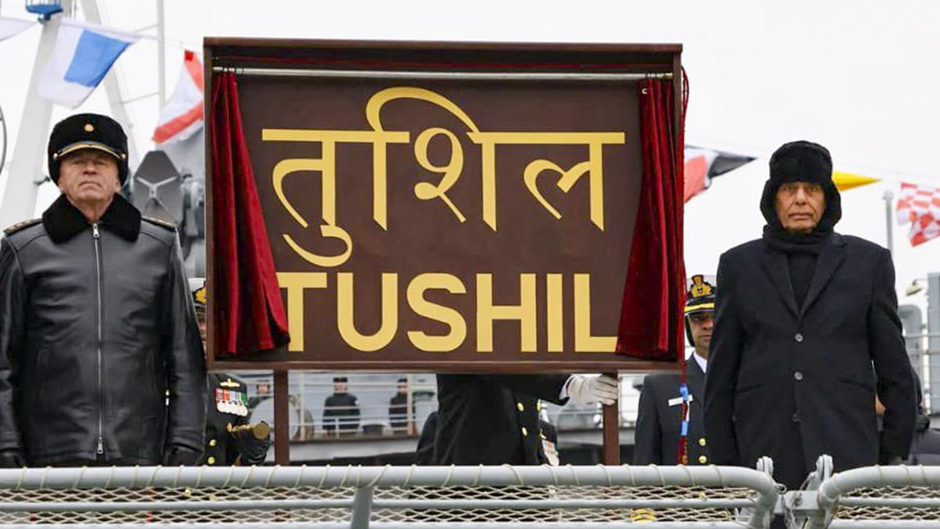- Courses
- GS Full Course 1 Year
- GS Full Course 2 Year
- GS Full Course 3 Year
- GS Full Course Till Selection
- Answer Alpha: Mains 2025 Mentorship
- MEP (Mains Enrichment Programme) Data, Facts
- Essay Target – 150+ Marks
- Online Program
- GS Recorded Course
- Polity
- Geography
- Economy
- Ancient, Medieval and Art & Culture AMAC
- Modern India, Post Independence & World History
- Environment
- Governance
- Science & Technology
- International Relations and Internal Security
- Disaster Management
- Ethics
- NCERT Current Affairs
- Indian Society and Social Issue
- NCERT- Science and Technology
- NCERT - Geography
- NCERT - Ancient History
- NCERT- World History
- NCERT Modern History
- CSAT
- 5 LAYERED ARJUNA Mentorship
- Public Administration Optional
- ABOUT US
- OUR TOPPERS
- TEST SERIES
- FREE STUDY MATERIAL
- VIDEOS
- CONTACT US
INS Tushil commissioned into Indian Navy in Russia
INS Tushil commissioned into Indian Navy in Russia
11-12-2024

- On December 9, 2024, the Indian Navy formally commissioned the INS Tushil, a state-of-the-art stealth guided missile frigate, at Kaliningrad, Russia.
- The event marked a significant milestone in India-Russia defence relations, highlighting the deep strategic ties between the two nations.
- The commissioning of INS Tushil also reflects India’s growing technological capabilities and commitment to strengthening its maritime defence.
Key Highlights:
-
INS Tushil: A New Era of Defence Collaboration:
- Class & Design: INS Tushil is an upgraded version of the Krivak III class frigate under Project 1135.6.
- The ship’s design is based on the Talwar-class and Teg-class frigates that are already in service in the Indian Navy.
- In October 2016, India and Russia signed a deal for four stealth frigates, two to be built in Russia and two to be constructed at Goa Shipyard Limited under technology transfer.
- INS Tushil is one of the two additional Krivak-class frigates under construction in Russia, with the 2nd frigate (INS Tamal) expected to be delivered by early 2025.
- Collaboration: The commissioning exemplifies India and Russia’s strong defence cooperation, with the Indian Navy and Russian industries working together.
- INS Tushil reflects India's increasing reliance on "Made in India" content, with significant local production, contributing to India’s vision of becoming an Aatmanirbhar Bharat (Self-Reliant India).
-
Ceremonial Commissioning:
- The ceremony began with a joint Guard of Honour presented by the ship’s crew and the Russian Baltic Fleet personnel.
- The Commanding Officer designate, Captain Peter Varghese, formally accepted the ship's commissioning warrant, marking the ship’s induction into the Indian Navy.
- The ceremony concluded with the hoisting of the Indian Naval ensign, symbolizing the ship’s official entry into active service.
-
Strategic Significance:
- INS Tushil represents India's growing maritime power, capable of executing blue-water operations in various forms of naval warfare across air, surface, underwater, and electromagnetic domains.
- Advanced Weaponry: The ship is equipped with cutting-edge weapon systems, including:
- BrahMos supersonic cruise missiles (jointly developed by India and Russia).
- Shtil Surface-to-Air missiles with enhanced range capabilities.
- Advanced anti-submarine torpedoes and rockets.
- Upgraded medium-range anti-aircraft and surface guns with advanced stealth features.
- Optically-controlled close-range rapid-fire gun system.
- Helicopter Capabilities: The ship is capable of embarking Kamov 28 and Kamov 31 helicopters, providing enhanced capabilities for anti-submarine warfare and airborne early warning.
-
India-Russia Defence Collaboration:
- Joint Technological Development: Defence Minister Rajnath Singh highlighted the growing cooperation between India and Russia in areas like Artificial Intelligence, cybersecurity, space exploration, and counter-terrorism.
- The commissioning of INS Tushil reflects the deepening of this partnership, with both countries working together to enhance their technological and defence capabilities.
- Aatmanirbhar Bharat: Mr. Singh praised Russia’s support for India’s vision of self-reliance, noting that many components of INS Tushil are “Made in India.”
- He emphasized that the collaboration between the two countries shows how India is progressing towards technological excellence through partnerships with global powers like Russia.
-
Ship’s Specifications and Capabilities:
- Keel Laid: The keel of INS Tushil was laid on July 12, 2013, and it was launched in October 2021.
- The ship’s commissioning followed extensive trials to ensure its combat readiness.
- Sea Trials: The ship completed its maiden sea trials in January 2024, followed by factory trials, State Committee Trials, and delivery acceptance trials by September 2024.
- These trials confirmed the ship’s readiness for service, with successful firing tests of all Russian weapon systems.
- Speed and Power: INS Tushil is powered by an advanced gas turbine propulsion system and can achieve speeds exceeding 30 knots.
-
Indian Navy's Role in Regional Security:
- Defence Minister Rajnath Singh reiterated the Indian Navy's commitment to ensuring peace and security in the Indian Ocean Region (IOR).
- India’s naval forces have played a key role in counter-piracy operations, combating arms and drug smuggling, and ensuring safe maritime trade in critical international shipping routes.
- The Indian Navy is also committed to providing humanitarian assistance and disaster relief in the region, acting as a first responder in times of crisis.
Strategic and Technological Impact:
- Maritime Security: The induction of INS Tushil boosts India’s ability to project power in the Indian Ocean Region, a vital area for global maritime trade.
- The ship’s advanced weaponry and systems will enable the Indian Navy to secure key shipping lanes and safeguard India’s maritime borders.
- Technological Advancement: The ship shows technological cooperation between Indian and Russian industries, reflecting India’s growing capabilities in advanced naval technologies and indigenous manufacturing.
- Strengthening Bilateral Ties: The commissioning shows the deep strategic partnership between India and Russia, enhancing defence cooperation and collaboration in modern defence technologies.
Conclusion:
The commissioning of INS Tushil marks a significant leap forward in the India-Russia defence relationship, reinforcing both nations’ commitment to advancing military technology and ensuring regional security. Equipped with state-of-the-art systems and technologies, INS Tushil enhances India’s naval capabilities and strengthens its position as a key player in the Indian Ocean Region. The collaboration between India and Russia in building such sophisticated platforms reflects the growing strategic ties and mutual commitment to peace and security.




